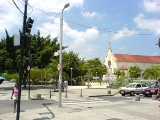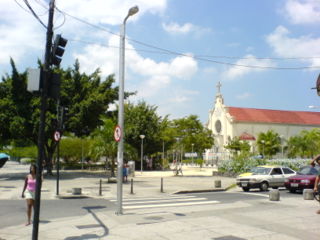
Realengo
Encyclopedia

Rio de Janeiro
Rio de Janeiro , commonly referred to simply as Rio, is the capital city of the State of Rio de Janeiro, the second largest city of Brazil, and the third largest metropolitan area and agglomeration in South America, boasting approximately 6.3 million people within the city proper, making it the 6th...
. The lower and middle class neighborhood is between the Mendanha and Pedra Branca mountains. It is located between the mountains of Pedra Branca (White Rock) and Mendanha in the northern of the called West Zone (Zona Oeste) of the city, owned and names the XXXIII Administrative Region which encompasses the entire east around the neighborhood. Usually has the highest temperatures in the city, even though the winter nights are often cold because of the proximity to the mountains. Created on November 20, 1815, every year on this day your birthday is celebrated with the Week of Realengo. According to popular tradition, his name would have been short for the Real Engenho (Royal Mill) which was Real Eng°, posted on the board on top of the tramway and, over time, became popularly Realengo. However, another source comes from the phrase "Terras Realengas" (Land Realengas) because they were far from the court, as they were called the land of the region. Pedro I of Brazil used to go to the farm of Santa Cruz
Santa Cruz, Rio de Janeiro
Santa Cruz is an extensive, populous, mostly low-income neighborhood in the West Side of Rio de Janeiro, the most distant of the central area of the city, at about from downtown Rio. Traversed by the Central do Brasil suburban railway, it has a quite diversified landscape, with rural, commercial,...
(Saint Cross) by the Estrada Real de Santa Cruz (Royal Road to Santa Cruz), passing by the Real Engenho, where he often stayed.
Human Development Index (HDI)
According to a survey by the Instituto Pereira Passos (Pereira Passos Institute) and the Brazilian Institute of Geography and Statistics, in 2000 Realengo reached the 89th position in the rank of HDIHuman Development Index
The Human Development Index is a composite statistic used to rank countries by level of "human development" and separate "very high human development", "high human development", "medium human development", and "low human development" countries...
.
Public Health
State Hospital Albert Schweitzer serves a population of around 700 thousand inhabitants. The Realcordis Hospital is affiliated to Rede D'Or. São Miguel Hospital replaced the former Serv Baby Maternity and Hospital. There is also a unit of UPA 24H (Unidade de Pronto Atendimento 24 Horas - Emergency Service Unit).Nature
Realengo still has remnants of rainforest that are home to endangered animals such as Golden lion tamarinGolden Lion Tamarin
The golden lion tamarin also known as the golden marmoset, is a small New World monkey of the family Callitrichidae...
, armadillo
Armadillo
Armadillos are New World placental mammals, known for having a leathery armor shell. Dasypodidae is the only surviving family in the order Cingulata, part of the superorder Xenarthra along with the anteaters and sloths. The word armadillo is Spanish for "little armored one"...
, macaw
Macaw
Macaws are small to large, often colourful New World parrots. Of the many different Psittacidae genera, six are classified as macaws: Ara, Anodorhynchus, Cyanopsitta, Primolius, Orthopsittaca, and Diopsittaca...
, crowned kinglet, monkey frog
Monkey Frog
The monkey frogs are a group of species of tree frogs which are characterized by long limbs and a lack of webbing between their toes. This last trait allows them to grasp branches and to climb trees in the manner of a monkey . They live in Peru, in rainforests such as the Tambopata Rainforest...
, and plants like orchids, bromelia
Bromelia
Bromelia is a genus of the botanical family Bromeliaceae, subfamily Bromelioideae. Bromelia species are characterized by flowers with a deeply cleft calyx. The genus is named after the Swedish medical doctor and botanist Olaf Bromelius .-Species:* Bromelia agavifolia Brongniart ex Houllet*...
s and other. In sub-district Barata is a subsede Parque da Pedra Branca (White Rock Park), the door to the Maciço da Pedra Branca (Massif of White Rock). Inaugurated on October 17, 2009 by Governor Sérgio Cabral Filho
Sérgio Cabral Filho
Sérgio de Oliveira Cabral Santos Filho , is a Brazilian politician and journalist.In the 2006 Brazilian general elections, he was elected governor of the state of Rio de Janeiro; he was sworn into office on January 1, 2007....
, the government spent R$ 786,000.00 (seven hundred eighty-six reais) in equipment such as water tanks and strings, it also runs a post of Firemen to maintain order in the reserve.
History
The so-called Terras originated, according to some historians, the Carta Régia (Royal Charter) of June 27, 1814, by which John VI of PortugalJohn VI of Portugal
John VI John VI John VI (full name: João Maria José Francisco Xavier de Paula Luís António Domingos Rafael; (13 May 1767 – 10 March 1826) was King of the United Kingdom of Portugal, Brazil and the Algarves (later changed to just King of Portugal and the Algarves, after Brazil was recognized...
, also a prince, gave land grants in the Senate of Rio de Janeiro land situated in Campo Grande (Big Field), called realengos, arising because of territorial conquest by the discovery of the country were incomparable to real assets. The grant of land in what is now the neighborhood Realengo, center and periphery, was intended to serve only as grazing cattle, supplying meat to butchers of the city. These lands were banned from any sale by the disposition requiring that the Senate to measure and bring them clean in a position to serve the purpose they were donated by that charter.
The village of Realengo was limited by the Senate of Rio de Janeiro, by the provision of July 18, 1814, taking over the Court of the lands tested on the Estrada da Santa Cruz (Road of Saint Cross) and depths of more than twenty fathoms. Despite the express prohibition of lease, sale or other disposition, the Senate, after a certain time, taking advantage of the charter of June 27 has all land granted for such reasons that in addition to the ordinance November 20, 1815 the Prince Regent known as royal notice, on December 20, 1815 that allowed only the tenure of the party which was tested on the Estrada de Santa Cruz (and depths of 20 fathoms the maximum, not at all Realengo).
The neighborhood had its first settlers, slaves and immigrants from the Portuguese island of the Azores
Azores
The Archipelago of the Azores is composed of nine volcanic islands situated in the middle of the North Atlantic Ocean, and is located about west from Lisbon and about east from the east coast of North America. The islands, and their economic exclusion zone, form the Autonomous Region of the...
, by order of the Prince Regent Dom João, later Dom João VI
John VI of Portugal
John VI John VI John VI (full name: João Maria José Francisco Xavier de Paula Luís António Domingos Rafael; (13 May 1767 – 10 March 1826) was King of the United Kingdom of Portugal, Brazil and the Algarves (later changed to just King of Portugal and the Algarves, after Brazil was recognized...
. When they devoted themselves to agriculture for grazing leading products such as sugar, molasses, alcohol and rum, the port of Guaratiba. Research shows that there was only one mill in Realengo as everything was taken to undergo transformation into other properties.

